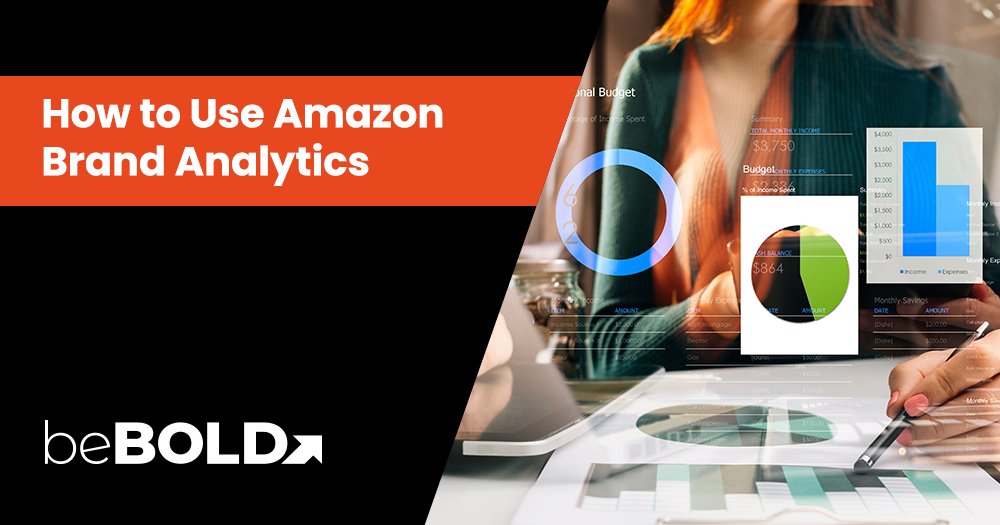Sellers on Amazon need every advantage they can get to optimize their Amazon sales strategy. With millions of products vying for attention, standing out in the crowd and driving sales can be challenging. That’s where Amazon Brand Analytics comes into play – a powerful tool that equips sellers with valuable data and insights.
The Amazon Brand Analytics platform provides sellers with a wealth of information, enabling them to enhance product listings, target the appropriate audiences, and ultimately increase sales.
Whether you’re a seasoned seller looking to refine your approach or just starting on the platform, harnessing the power of Amazon Brand Analytics can help you improve your product sales and achieve your business goals. This in-depth guide will dive into the functionalities and benefits of Amazon’s brand analytics tools and provide a step-by-step guide on effectively leveraging this feature.
What Is Amazon Brand Analytics?
Amazon Brand Analytics is an add-on feature for sellers registered to Amazon Seller Central. The dashboard offers customer data on search terms, customer information, competitor performance, and buyer behavioral trends. This information can help users optimize their actions on Amazon.

How is Amazon Brand Store Different from Amazon Brand Analytics?
Amazon Brand Store and Amazon Brand Analytics are two distinct tools offered by Amazon to help brands enhance their presence on the platform. Both serve distinct purposes within the Amazon platform, each catering to different aspects of selling and brand management. Here’s how they differ:
|
Amazon Brand Store |
Amazon Brand Analytics |
|
|
Purpose |
A customizable storefront on Amazon that allows sellers to showcase their brand and products in a personalized way |
A powerful data-driven tool that provides insights into customer behavior, helping brands make informed decisions. |
|
Functionality |
Enhances the shopping experience by offering a branded environment with product displays, images, and videos. |
Delivers data on search terms, top products, market basket analysis, and demographics. |
|
Audience |
Engages potential customers directly, increasing brand visibility. |
Used by sellers and marketers to optimize campaigns and product strategies. |
|
Benefit |
Boosts brand recognition, improves customer experience, and drives sales. |
Offers insights into customer preferences, enhancing product listings and marketing. |
Who Should Use Amazon Brand Analytics?
Amazon Brand Analytics is a powerful tool designed to provide brands with valuable insights into their performance on the Amazon marketplace. Here's who should use it:
Brand Owners
Brand owners can leverage Amazon Brand Analytics to gain valuable insights into their brand's performance on the platform. By tracking sales data, customer behavior, and competitor activity, they can make strategic decisions to optimize product listings, marketing campaigns, and overall brand strategy.
Manufacturers
Manufacturers can use Amazon Brand Analytics to monitor the performance of their products sold through Amazon. By analyzing sales data and customer feedback, they can identify areas for improvement, optimize product offerings, and ensure their products meet unique customer needs.
Retailers
Retailers selling on Amazon can benefit from Amazon Brand Analytics by understanding their target audience's preferences and purchasing behaviors. This information can help them optimize product assortment, pricing strategies, and marketing efforts to drive sales and increase customer satisfaction.
Marketing Agencies
Marketing agencies working with brands selling on Amazon can use Amazon Brand Analytics to develop effective marketing strategies. They can create targeted campaigns that drive brand visibility and increase sales by analyzing customer behavior, search trends, and competitor activity.
How Does Amazon Brand Analytics Work?
Here’s how the process generally works:
1. Accessing Brand Analytics
To access Amazon Brand Analytics, sellers must register in the Amazon Brand Registry program. Once enrolled, they can log in to their Seller Central account and navigate to the Brand Analytics Dashboard.
2. Navigating the Dashboard
The dashboard presents various sections with data and reports, which you can peruse at your leisure. There are six detailed reports, namely:
|
Amazon Search Terms |
Keywords shoppers are using to find products. |
|
Demographics |
Aggregate customer location, gender, age, household income, and marital status data. |
|
Item Comparison |
Competitor products that customers view after your listing. |
|
Alternate Purchase |
Competitor products that customers buy after viewing your listing. |
|
Market Basket |
Bundles of items customers frequently buy together. |
|
Repeat Purchase Behavior |
Products customers buy repeatedly. |
Source: sell.amazon.com
3. Leveraging the Data
With the data at your fingertips, you can analyze the information and make informed decisions about product positioning, inventory management, marketing strategies, and listing decisions. Sellers can optimize their sales strategies, improve product visibility, and enhance the overall customer experience on the platform using customer preferences and behavior.
How to Use Amazon Brand Analytics to Increase Sales: 4 Strategies
Amazon Brand Analytics is a powerful ally that helps sellers boost their sales on the platform. Here are four data-driven strategies to optimize your products, keyword usage, and marketing efforts to maximize your sales.
1. Leverage competitor insights for product and listing optimization
You can use the dashboard’s Item Comparison and Alternate Purchase reports to inform you of what competitors are doing to attract customers from your listing. You can then adjust your products to align with customer preferences and optimize your product’s appeal for higher conversion rates.
For example, a seller of beauty products on the Amazon Brand store might notice that their competitor who sells vegan products is performing well. They can then expand their catalog to include animal-free products to attract more customers.
You can also analyze competitor pricing data to ensure your products aren’t overpriced. You can then use this information to offer promotions, discounts, and bundle deals to entice customers to choose your products over others. Strategic pricing and promotions can drive sales and create a sense of urgency, leading to increased conversions.
2. Target the right audience
You can have the perfect product and listings, but it won’t matter if it doesn’t reach the right people. The Demographics report can help you refine your Amazon sales strategy based on age, gender, and location data.
Adequately segmenting your audience can help you personalize your marketing and optimize your resource allocation. You can maximize the impact of your marketing campaigns and drive qualified, high-quality traffic that will most likely purchase your offerings.
The Amazon Search Terms report can reveal what your target customers, including Amazon shoppers, are searching for to synergize with your demographic data and enhance your ad campaigns. You can tap into Amazon’s suite of in-house advertising tools, such as Sponsored Products, to draw attention to your listings. You may also partner with a third-party Amazon agency to gain access to their expertise.
The Amazon Search Terms report can reveal what your target customers, including Amazon shoppers, are searching for to synergize with your demographic data and enhance your ad campaigns. You can tap into Amazon’s suite of in-house advertising tools, such as Sponsored Products, to draw attention to your listings. You may also partner with a third-party Amazon agency to gain access to their expertise.
3. Optimize supply chain and inventory
The Market Basket and Repeat Purchase Behavior reports are your best friends when managing your supply chain and inventory. Knowing which products customers co-purchase or repurchase frequently can create product bundles or cross-selling opportunities for your business.
An Amazon beauty seller can, for instance, use the reports to identify that customers frequently purchase multiple skin care products together. The seller can then bundle these items in a promotion to increase their sales.
This information also helps you optimize your inventory based on customer behavior. You’ll always know which products to stock and when customers will most likely purchase them. Minimize stockouts and maximize your sales potential.
4. Measure success and adjust strategies
The most crucial benefit of Amazon Brand Analytics and Seller Central is the ability to monitor and evaluate your products’ performance regularly. You can keep track of sales trends and customer behaviors to identify successful strategies and areas for improvement.
It would be best to use the available tools to adjust your sales strategies with the shifting demands of the platform and its users. Being adaptable and open to tuning your listings based on real-time data will help you stay competitive and continuously improve your sales performance.
Conquering Amazon through Data
In the fiercely competitive world of Amazon, conquering the marketplace requires a great product, a strong brand, and the ability to effectively harness the power of data. Amazon Brand Analytics is the perfect ally for this endeavor. It provides valuable insights that can fuel your data-driven sales strategies.
If you want a partner that knows how to use data to its fullest, consider partnering with beBOLD! We are an Amazon SEO agency specializing in helping eCommerce brands achieve their potential. Contact us today to learn more!
Frequently Asked Questions (FAQs) About Amazon Brand Analytics
Is Amazon Brand Analytics free?
Yes, Amazon Brand Analytics is free for brand-registered sellers on Amazon. However, to access it, sellers must be enrolled in the Amazon Brand Registry program, which ensures that the seller owns the brand and meets certain eligibility requirements. Once registered, amazon vendors can also use Amazon Brand Analytics at no additional cost to gain valuable insights into customer behavior, search trends, and product performance.
How can sellers leverage customer purchasing behavior insights from Amazon Brand Analytics for cross-selling or upselling strategies?
Amazon Brand Analytics allows sellers to understand what products customers often buy together (Market Basket Analysis). Sellers can leverage this information for effective cross-selling and upselling strategies by bundling related products, creating targeted promotions, or optimizing product listings to showcase complementary items.
This strategic use of customer behavior insights can also enhance the shopping experience and increase the likelihood of customers adding more items to their carts.
Are there any limitations or considerations sellers should be aware of when interpreting data from Amazon Brand Analytics?
Yes, there are some limitations and considerations sellers should be aware of when interpreting data. For instance, the data provided by Amazon Brand Analytics is based on a sample of customers and may not represent the entire customer base. Data may also be based on a subset of total customer interactions.
Additionally, data provided by Amazon Brand Analytics is historical but may not reflect the most current trends or customer behavior. It's important to use it in conjunction with other data sources and to interpret the data with caution.
To maximize its utility, sellers should complement the tool with other data sources and industry knowledge, ensuring a comprehensive and informed approach to decision-making.
Can Amazon Brand Analytics assist in optimizing PPC product targeting? What features contribute to more effective PPC campaigns?
Yes, Amazon Brand Analytics can assist in optimizing ppc product targeting. It provides information on customer search terms and purchase behavior, which can help sellers identify relevant keywords and optimize their PPC campaigns.
Some features within the tool that contribute to more effective PPC campaigns include the Search Query Performance dashboard, which lists keywords customers use to find your brand, and the Market Basket Analysis dashboard, which helps you identify products that are frequently purchased together.
To refine their PPC keyword strategy, sellers can analyze popular and relevant search terms, create more targeted and effective PPC campaigns, and ensure that their ads are displayed to the most relevant audience.
What Amazon Brand Analytics tools or features aid sellers identify niche markets and tailor their products accordingly?
While Amazon Brand Analytics does not have specific tools or features for identifying niche markets, it provides information on customer demographics, search terms, and purchase behavior that can help sellers identify new product opportunities and emerging market trends, ultimately enhancing their advertising strategies. Sellers can use this information to create targeted advertising campaigns and adjust their product offerings to meet customer demand.
How does Amazon Brand Analytics contribute to understanding customer loyalty?
By leveraging the insights from Amazon Brand Analytics, sellers can tailor their strategies to enhance customer satisfaction and encourage repeat business over time. For instance, the Repeat Purchase Behavior metric can gauge customer loyalty and identify which products are more likely to attract repeat buyers.
To foster long-term customer relationships, sellers can implement strategies such as loyalty programs, offering exclusive discounts or promotions to repeat customers, and ensuring exceptional customer service. Providing a positive and consistent buying experience, actively addressing customer feedback, and engaging with customers through personalized communication can all build trust and loyalty.
Conquering Amazon through Data
In the fiercely competitive world of Amazon, conquering the marketplace requires a great product, a strong brand, and the ability to effectively harness the power of data. Amazon Brand Analytics is the perfect ally for this endeavor. It provides valuable insights that can fuel your data-driven sales strategies.
If you want a partner that knows how to use data to its fullest, consider partnering with beBOLD! We are an Amazon SEO agency specializing in helping eCommerce brands achieve their potential. Contact us today to learn more!







Comments